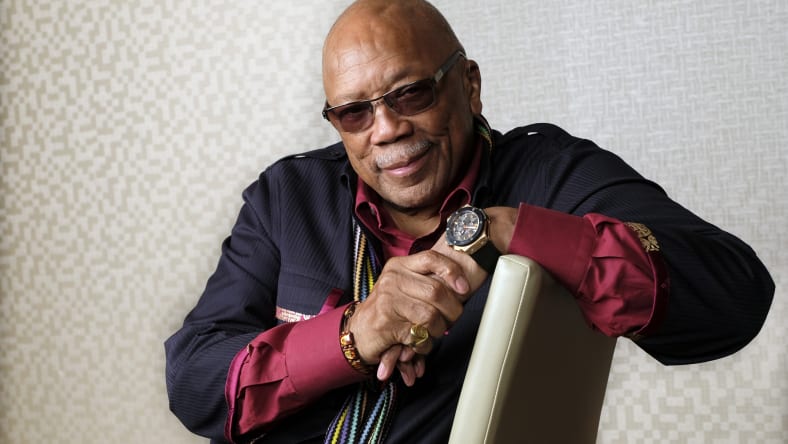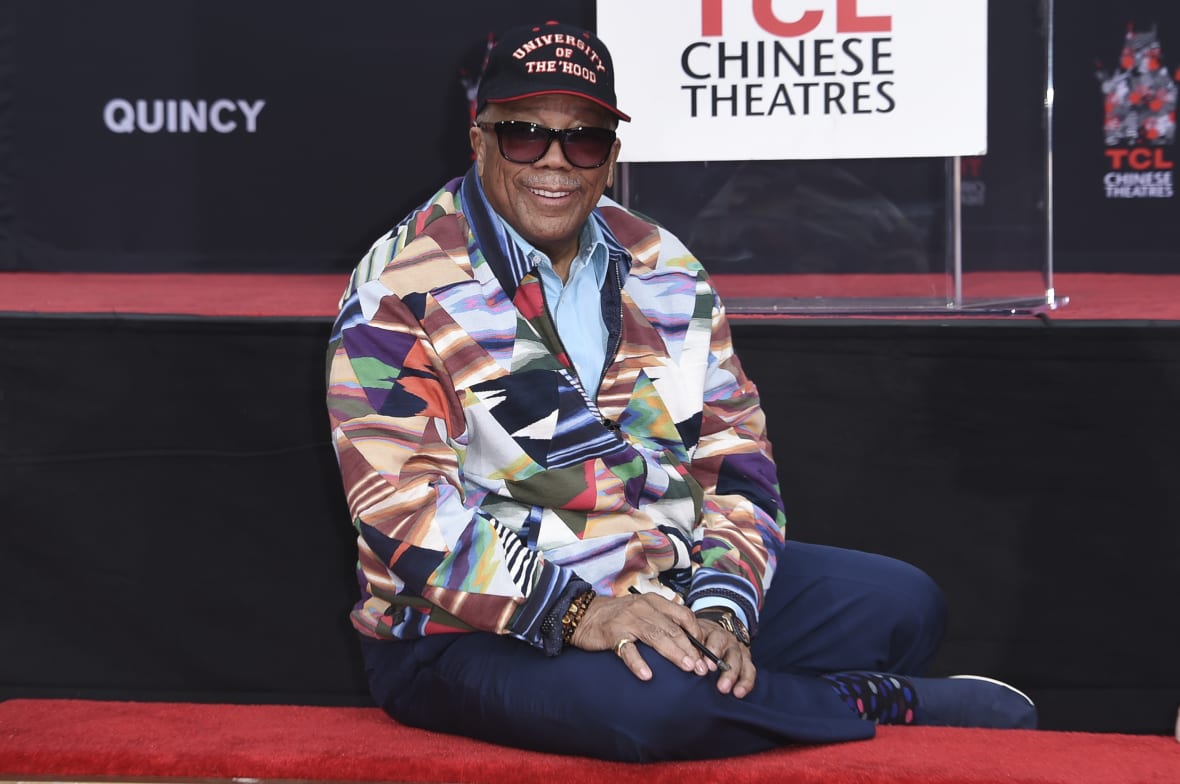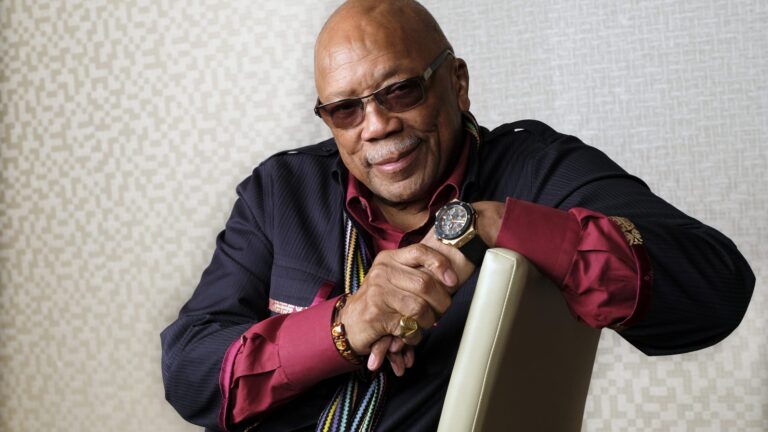
Editor’s note: The following article is an editorial and the opinions expressed are those of the author. Learn more opinions on the Grio.
In 1933, Jim Crow was the faceless American monarch. Former slaves still roamed the country. The radio was the main source of daily entertainment. People watched the news in movie theatres.
Since Quincy Delight Jones, Jr. was born on March 14, 1933, a lot has changed. It sparked much of the country’s cultural and entertainment evolution that still exists 90 years later.
Coming from a modest at best and dangerous at worst Chicago upbringing, Jones would go on to be the North Star for so many things that American music and black culture have come to love and rely on to this day.

Jones’ distinctions are so vast that they border on mythology. He became an icon by supporting the heroes of his day, like Billy Eckstine, Dinah Washington, Count Basie, Frank Sinatra and Ray Charles.
The 28-time Grammy winner defined the role of music producer and provided the model for contemporary pop music, through collaborations with Michael Jackson, George Benson, The Brothers Johnson and Donna Summer. His discerning sense of progression helped him mentor future stars like James Ingram, Patti Austin, Tamia and Will Smith. As the founder of Vibe Magazine, he put black entertainment culture on the same pedestal that had hitherto been reserved for white artists.
Jones’ resume as a producer and impresario is so oversized that it casts a monolithic shadow over another phase of his career that has been equally crucial to the success of black creatives: film music.
John Williams, Hans Zimmer, Danny Elfman and Ennio Morricone are perhaps the first names that come to mind when you think of film composers. However, Jones was able to work his way into this pantheon in the 1960s, establishing himself as the go-to composer of film noir. He has composed for more than 33 films and television shows over three decades, including “In the Heat of the Night”, “Roots”, “The Wiz” and “The Color Purple”.

Jones’ presence and persistence opened up opportunities for a group of film noir composers, from Isaac Hayes and Curtis Mayfield to Terence Blanchard and Kris Bowers.
In 1964, when Jones was 31, he had already lived enough life for two people. He was ahead of his peers, from touring with Lionel Hampton to graduating from high school, from studying with Nadia Boulanger in Paris to arranging for Dinah Washington, Dizzy Gillespie and Louis Armstrong.
That year, after working a few years as vice president of A&R for Mercury Records and producing a string of pop hits for Leslie Gore, he was offered a 20-year contract worth $1 million. dollars, according to his 2022 book, “12 Notes: On Life and Creativity.” A salary of $50,000 a year (over $480,000 a year in today’s dollars after adjusting for inflation) is a dream for most. But that wasn’t enough for Jones.
He turned down a lucrative salary with unprecedented job security because he saw a void in the entertainment industry. He realized that black composers scored almost no films. At the time, Duke Ellington was one of the only notable black composers for a film (1959’s “Anatomy of a Murder” with Jimmy Stewart). Although the music endured like much of Ellington’s work, it was indistinguishable from any other jazz recording.
Less than 10 years earlier, Jones studied string arrangements in Paris under Boulanger, who trained composers like Aaron Copeland. Jones began to master classical music, then merged it with his knowledge of bebop and big band jazz, which he acquired through the teachings of Clark Terry, Hampton and Charles.

Jones said in his 2021 Neflix documentary, “Quincy,” that cultural bias prevents him and other black composers from writing for films. “There was a lot of reluctance to ‘how can you write for a white star,'” Jones said. “I thought it was a dream I had to hold on to.”
The bet is successful. In 1964, director Sidney Lumet gave Jones his first assignment as a film scorer for his film, “The Pawnbroker.” In this film, Jones showed his penchant for matching each scene with appropriate emotion.

He was able to show off his seemingly bottomless melodic and thematic range over the next 30 years. His score for 1967’s “In the Heat of the Night” incorporated jazz, blues, bluegrass and classical elements while providing ebbs and flows of tension and resolution.
When it comes to television composition, Lalo Schifrin and Henry Mancini were the first called. Schifrin, a prolific film composer, also crafted iconic TV themes like “Mission: Impossible.” Mancini’s theme to “The Pink Panther” became eternally enduring, thanks to the lively spectacle.
Jones took advantage of his opportunities to write television themes, composing songs that are still part of the musical lexicon today. His “Ironside” theme was repurposed for Quentin Tarantino’s “Kill Bill” films and given new life in the 21st century. His “The Street Beater” opened “Sanford and Son” and continues to be a benchmark of television themes in the black community. His score for the mini-series “Roots” allowed him to underpin the urgent polyrhythms and scattered melodies of West Africa.

While he had the education and experience to handle it, Jones told “Quincy” that the process is more thoughtful than technical. “When composers get into a movie, I think they spend the hardest parts scratching the bullshit. You really have to scratch until there’s only the truth left because I don’t think that you can really write or create anything without feeling in agreement with the truth.
The dawn of 1970s Blaxploitation films gave contemporary black musicians a chance to score films. Hayes’ score for “Shaft” won him an Oscar. Mayfield has hit paydirt with several soundtracks over the decades, such as “Claudine”, “Let’s Do It Again”, “Sparkle”, and his magnum opus, “Superfly”.
Without Jones, the path wouldn’t have been clear for artists like Marvin Gaye, Willie Hutch and Norman Whitfield to create lasting soundtracks and scores for films like ‘Trouble Man’, ‘The Mack’ and ‘Car Wash’. , respectively. ; music that has survived the films they accompanied.
Today, the landscape of film composers is different. More and more black writers are having opportunities and succeeding in scoring for film and television. Contemporary jazz musicians have followed in Jones’ footsteps, moving from players to scorers.
Like Jones, Blanchard became a star as a trumpeter. But the New Orleans musician is just as respected as a film composer. His music has accompanied most of Spike Lee’s films, including “Jungle Fever”, “Malcolm X” and “When the Levees Broke”.

Bowers is one of today’s most prolific black composers for television and film. In addition to scoring films like “Space Jam: A New Legacy” and “Respect,” he earned Emmy Award nominations for music for Netflix series “When They See Us” and “Bridgerton.”
Robert Glasper has turned his Grammy-winning ‘Black Radio’ albums into a lucrative career as a media composer. He lent his pen to shows like “Bel-Air”, “The Best Man: The Final Chapters” and films like “The Photograph”.
Writers like Bowers, Glasper, Derrick Hodge, Matthew Head, Michael Abels and Amanda Jones all use Jones as a beacon as they navigate the choppy waters of Hollywood.

Matthew Allen is a music and culture entertainment writer for theGrio. He is an award-winning music journalist, television producer and director based in Brooklyn, NY. He has interviewed Quincy Jones, Jill Scott, Smokey Robinson and many more for publications including Ebony, Jet, The Root, Village Voice, Wax Poetics, Revive Music, Okayplayer and Soulhead. Her video work can be seen on PBS/All Arts, Brooklyn Free Speech TV and BRIC TV.
TheGrio is FREE on your TV via Apple TV, Amazon Fire, Roku and Android TV. Also, please download theGrio mobile apps today!




Add comment